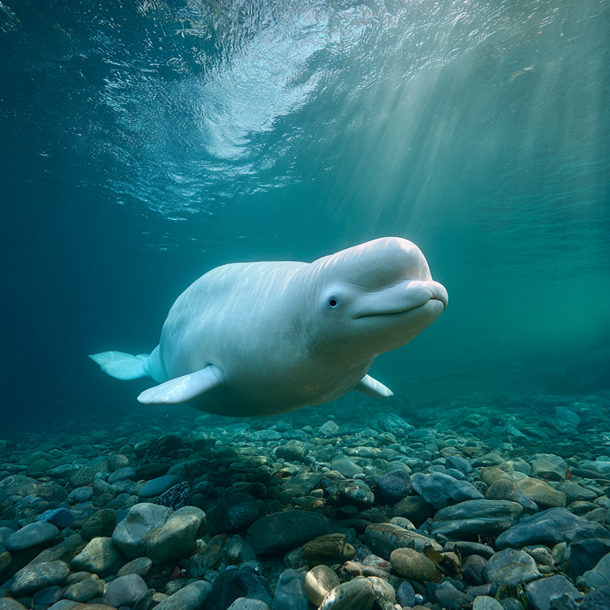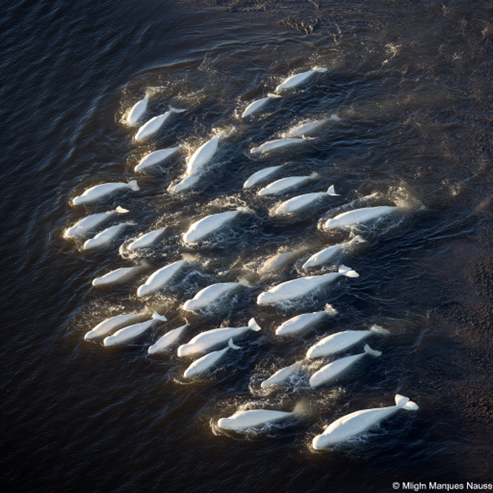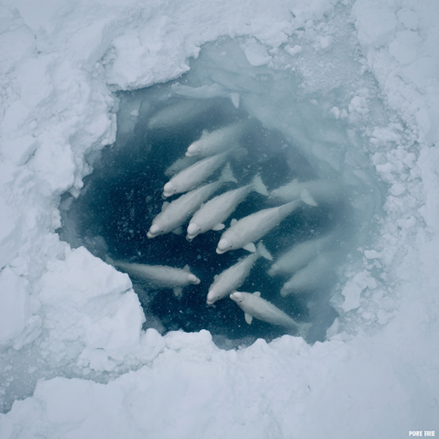Beluga Whale
The White Whale of the North
The beluga whale, with its distinctive white coloration and bulbous forehead, is one of the most recognizable of all cetaceans. Found throughout the Arctic and sub-Arctic, the beluga is a social and highly vocal animal, earning it the nickname "canary of the sea." Like the narwhal, the beluga is a member of the family Monodontidae and is uniquely adapted to life in some of the most extreme marine environments on Earth. Yet despite its wide distribution, many distinct beluga populations are under severe threat, victims of habitat loss, pollution, and climate change.

The distinctive white coloration and bulbous melon of an adult beluga.
Physical Characteristics
Adult belugas range from 13 to 20 feet (4 to 6 meters) in length and can weigh between 2,000 and 3,500 pounds (900 to 1,600 kg). Males are generally larger than females. The beluga's most striking feature is its pure white skin in adulthood, though calves are born gray and gradually lighten as they mature.
The beluga's prominent melon—a large, rounded forehead—is a sophisticated biological organ used for echolocation. Unlike most cetaceans, the beluga can change the shape of its melon to modulate and focus sounds, creating a highly sophisticated acoustic system for communication and navigation. The beluga also lacks a dorsal fin, instead possessing a tough dorsal ridge that helps it navigate under ice and break through thin ice to create breathing holes.
Perhaps most remarkably, the beluga has unfused cervical vertebrae, giving it exceptional neck flexibility. This allows the whale to turn its head independently of its body—a rare ability among cetaceans that proves invaluable for scanning the seafloor for prey and navigating complex underwater environments.
Adaptations to an Icy World
The beluga is a master of Arctic survival, with a suite of physical adaptations for life in a cold and dynamic environment. Its most obvious adaptation is its white coloration, which provides excellent camouflage from predators like polar bears and orcas amidst the ice floes. Calves are born grey and gradually turn white as they mature, reaching their full adult coloration around the age of sexual maturity.
Navigating the Ice
Structurally, the beluga is built for its icy habitat. It lacks a dorsal fin, which would be an impediment when swimming under large sheets of sea ice. Instead, it has a tough dorsal ridge that allows it to break through thin ice to create breathing holes. Like its close relative the narwhal, the beluga has unfused cervical vertebrae, which gives its neck extraordinary flexibility—allowing it to turn its head at a sharp angle to its body, crucial for scanning for prey on the seafloor and navigating complex underwater environments.
The beluga's thick blubber layer can account for up to 40 percent of its weight, providing both insulation in frigid waters and energy storage during lean times. Its distinctive melon—the bulbous forehead—is not just a physical characteristic but a sophisticated biological organ used for echolocation, allowing it to navigate and hunt in the dark Arctic waters.

A pod of belugas moves together through Arctic waters—highly social animals whose complex vocalizations earned them the nickname "canary of the sea."
The Sea Canary: A Social and Vocal Life
Belugas are highly social animals, typically living in pods of around 10 individuals, but they can form massive aggregations of hundreds or even thousands in their summering grounds in estuaries and river mouths. These summer gatherings are important social events, used for calving, molting, and socializing.
An Orchestra of Sound
It is in these social contexts that the beluga's vocal nature is most apparent. They are one of the most vocal of all cetaceans, producing an astonishingly diverse array of sounds. Their repertoire includes a wide range of clicks, whistles, chirps, trills, and squeals, which they use for communication, navigation, and hunting.
This complex vocal toolkit is essential for maintaining contact with pod members, coordinating group behaviors, and using echolocation to find food and navigate in the often dark and turbid Arctic waters. The beluga's melon can change shape to modulate and focus these sounds, creating a sophisticated acoustic communication system that has fascinated researchers for decades.
A Modern Mythology: The "Spy" Whale
While the beluga has long been a part of Inuit folklore, it has recently entered a new, modern mythology. In 2019, a lone beluga whale appeared in the waters of Norway, wearing a strange harness that appeared to be of Russian origin.
The Story of Hvaldimir
The harness, which seemed designed to carry a camera or other equipment and was stamped with "Equipment St. Petersburg," was removed by fishermen. The whale, nicknamed "Hvaldimir" (a combination of the Norwegian word for whale, hval, and Russian President Vladimir Putin's first name), remained in the area, seemingly accustomed to humans and responsive to hand signals.
This led to widespread global speculation that the whale was a trained Russian "spy," an escapee from a naval program designed to use marine mammals for military purposes. While Russia never officially responded to these allegations, both the United States and Russia are known to have military cetacean training programs, with Russian programs incorporating beluga whales.
Alternative theories suggested Hvaldimir might have been a therapy whale from a program for disabled children. Regardless of his origins, Hvaldimir became an international celebrity, beloved by locals and tourists alike for his friendly demeanor and playful interactions with humans. Tragically, Hvaldimir was found dead in August 2024 near Stavanger, Norway. The story of the "spy whale" has become a modern legend—a fascinating and slightly sinister example of how these intelligent animals can be drawn into the world of human conflict and intrigue.

Belugas navigate treacherous ice conditions—a habitat now rapidly changing due to climate change, with unpredictable ice patterns increasing the risk of deadly entrapments.
An Arctic Under Threat: Conservation and Current Struggles
Conservation Crisis
Global Status: Least Concern (IUCN)
Cook Inlet, Alaska: Critically Endangered
Cook Inlet Population: Fewer than 300 individuals (down from thousands)
Reality: Many isolated subpopulations are under severe threat
While the global beluga population is considered "Least Concern" by the IUCN, this status is misleading. It masks the reality of numerous distinct and geographically isolated subpopulations, many of which are under severe threat. The most extreme example is the Cook Inlet population in Alaska, which is genetically distinct and has collapsed to only a few hundred individuals, leading to its classification as Critically Endangered.
Modern Threats
Belugas face a range of threats, many of which are intensifying as the Arctic warms and becomes more accessible to human activity:
Climate Change
As an ice-dependent species, the beluga is on the front line of climate change. Rapid sea ice loss is altering their habitat, changing prey distribution, and increasing exposure to predators like orcas.
Underwater Noise Pollution
Increased shipping, oil and gas exploration, and industrial activities fill their once-quiet world with noise, interfering with communication and echolocation.
Pollution & Toxins
Industrial and agricultural pollutants bioaccumulate in the Arctic food web, concentrating in beluga blubber and causing impaired immune systems and reproductive failure.
Ice Entrapment
Increasing unpredictability of sea ice due to climate change leads to higher risk of savssats (ice entrapments), where entire pods become trapped in shrinking breathing holes.
References
- NOAA Fisheries. Beluga Whale. https://www.fisheries.noaa.gov/species/beluga-whale
- NOAA Fisheries. Recovery Plan for the Cook Inlet Beluga Whale (Delphinapterus leucas). https://www.fisheries.noaa.gov/resource/document/recovery-plan-cook-inlet-beluga-whale-delphinapterus-leucas
- Castellote, M. et al. Beluga whale (Delphinapterus leucas) acoustic foraging behavior and applications for long term monitoring. PLOS ONE (2021). https://pmc.ncbi.nlm.nih.gov/articles/PMC8631677/
- Brewer, A.M. et al. Communication in Cook Inlet beluga whales: Describing the vocal repertoire and masking of calls by commercial ship noise. Journal of the Acoustical Society of America 154(5): 3487-3505 (2023). https://pubs.aip.org/asa/jasa/article/154/5/3487/2925354/
- Vergara, V. et al. Effects of vessel noise on beluga (Delphinapterus leucas) call type use: ultrasonic communication as an adaptation to noisy environments? Biology Open (2025). https://pmc.ncbi.nlm.nih.gov/articles/PMC11957452/
- Ocean Conservancy. Celebrating Indigenous Stewardship of Beluga Whales. December 7, 2021. https://oceanconservancy.org/blog/2021/12/07/celebrating-indigenous-stewardship-beluga-whales/
- NPR. Russian 'spy whale' Hvaldimir found dead in Norway. September 3, 2024. https://www.npr.org/2024/09/03/nx-s1-5098968/hvaldimir-russian-spy-beluga-whale-dead
- Smithsonian Magazine. How Culture Guides Belugas' Annual Odysseys Across the Arctic. April 10, 2018. https://www.smithsonianmag.com/science-nature/culture-guides-belugas-annual-odysseys-across-arctic-180968761/